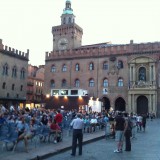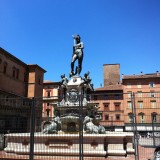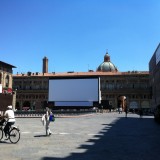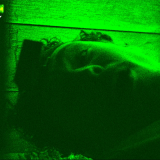Beyond Dodge College: Final Blog from Il Cinema Ritrovato
July 19, 2012
Hello everyone. Well, I’m packing up and getting ready to head out from Bologna tomorrow after an amazing week. Before I leave Italia, I figured I’d finish up writing about my time at this amazing festival. Onto the final three days of screenings!
Part 3 of 3. (Back to Part 1, Back to Part 2)
My third day at the festival began with a selection of short films shot in Italy in 1912, and they did not disappoint. La Cineteca Bologna had restored all of these films, and they gave an amazing insight into what this country was like a century ago. Not only were the films beautiful (is it possible to make Italy look unattractive on film?), but the tinting done to the film to add color to it was nothing short of stunning. The blues of the ocean were unlike anything I’d ever seen before. Most of the shorts were travelogues or shorts showing Italian life (people making straw hats), but a couple of them told stories of courtship and love, and they were quite entertaining.

After the screening, I made my way over to something rather unusual for this festival: a discussion of the Criterion Collection. Why would that be odd? Well, Criterion’s releases are Region 1 only, which means America. Italians, British, and the French, who made up the majority of the people at the festival, can’t watch these Blu-Rays and DVDs without a region free player, but since this is a festival for cinephiles, most of the people here either have a region free player or follow the company anyway. For those of you who aren’t familiar with Criterion, they release about 50 films a year on Blu-Ray and DVD, both older and contemporary films that are incredibly important to film history. At the panel were Kim Hendrickson, Lee Cline, and Liz Helfgott, and for about an hour, they simply took our questions about their company and talked about what their company does and what we have to look forward to. They told us about a release that’ll be out either late this year or early next that they haven’t announced yet, something that you wouldn’t expect to see on Criterion considering how it was massacred when it was released. That being said, the film has been restored and will be having its premiere at the Venice film festival this year, where its reclusive director will introduce it (ok, cluesters, go figure out what it is). After that was Sailor’s Luck, another Raoul Walsh film about three sailors on shore leave. Following that was Alfred Hitchcock’s Murder!, one of his first talkies. Even though the film is very talky and the camera is, for the most part, stagnant, the film moves along really well and is very enjoyable. After that would normally be the screening in the Piazza Maggiore, but it was cancelled due to the football match for Euro 2012 between Italy and Germany, which ended up with Italy winning 2-1 in a shocker. They’re playing Spain tonight and the winner wins the tournament (It’s going to be crazy tonight whether Italy wins or loses).
My final two days in Bologna seemed to focus more on lectures than on screenings, not because the movies weren’t good (there were plenty of great movies), but rather because the talks intrigued me so much. The day started with a talk by Andrea Kalas of Paramount, who discussed the studios recent restorations of both Samson and Delilah and Wings, both of which were showing at the festival. She talked about the difficulty of restoring the three-strip Technicolor of Samson and Delilah (which is essentially three restorations in one) but spent more time talking about Wings, which was the first film to ever win Best Picture. The restoration of Wings was extensive, from restoring the film from the best copy they had (a dupe negative from the 1950s) to re-recording the original score, and adding sound effects to the final product. When I saw the film the next day, it did not disappoint. It looked amazing and is now easily one of my favorite silent films ever. After that, I went to the 9th annual DVD awards hosted by the festival, in which a panel of five film historians/DVD enthusiasts gave out several awards. It was interesting because most of the winners were films I’d never heard of before, but they’re definitely on my map now. Following a lovely lunch, I returned to the theatre to see Raoul Walsh’s Me and My Gal, a truly fantastic comedy starring Spencer Tracy that is, unfortunately, unavailable on DVD. After that was an intense round-table discussion of digital vs. film stock in terms of both storage, presentation, and preservation. While one of the panelists was totally against digital, most agreed that the use of both, for the time being, is the best way to go in terms presentation, but in terms of storage and preservation, all the panelists agreed that digital was drastically inferior and that it will make future restorations of films shot digitally incredibly difficult, if not impossible. Once a digital file of a film is corrupted, you pretty much have to delete it. As we’ve seen with film, even if the camera negative is damaged, it can still be repaired and fixed, but most of the world doesn’t seem concerned with this dilemma, although I hope they soon will be. After a nap and dinner came my most anticipated screening of the entire festival: the brand new restoration of David Lean’s masterpiece Lawrence of Arabia. Grover Crisp, who oversees restorations at Sony, got up and spoke before the screening in the Piazza, telling us that this was the official premiere of the new restoration (it had screened at Cannes, but was not finished at the time). With that, the lights went down and Maurice Jarre’s majestic score began. From the Columbia logo alone, I knew that we were in for a treat. The movie has never looked better, and with each viewing, I come to love the film even more (it’s now certainly in my top five favorite films of all time). Even though the movie ran nearly four hours (the intermission was a mere five minutes as opposed to the normal ten to fifteen), it flew by. It was truly an amazing experience. For those of you who’d like to see it, it’s playing at the Academy theatre in Los Angeles on the 19th and the screening is open to the public (you can find tickets online). I highly suggest you go.
As great as Lawrence was, I did find one fault: because the screening ran so long, I overslept the next morning and missed Grover Crisp’s discussion of the restoration. Several of the other Chapman students here did go and told me that it was a fantastic discussion filled with lots of insight into the restoration process. I did, though, make it in time for Kevin Brownlow’s talk about David Lean and the film. Brownlow, who wrote Lean’s biography, spent about an hour discussing the film’s production and the troubles that led up to it (there had been numerous attempts to make a movie about T.E. Lawrence before Lean’s, but all of them fell apart before production). His talk gave us some fascinating insight into the creation of this epic film. After that, I saw my final Raoul Walsh film of the festival: Band of Angels. All I will say is even though the film has Clark Gabel and Sidney Poitier, stay away from it at all costs, it’s terrible. That night, in the Piazza, we saw three Chaplin shorts: Easy Street, The Immigrant, and The Rink. Sitting around with a couple thousand people laughing at the genius of Chaplin was a perfect way to finish off the festival.
Even with the terrible heat and humidity, I could not have enjoyed this trip any more. I want to thank Dean Bassett, Professor Emily Carman, and Dodge College for making this trip possible. If this trip happens again next year, I cannot recommend it enough to all of you out there, and to anyone who might read this who doesn’t attend Dodge College, you too should seriously consider going. It’s an unusual, but fantastic film festival in the food capital of Italy. What’s not to love?!
Ciao for now.





